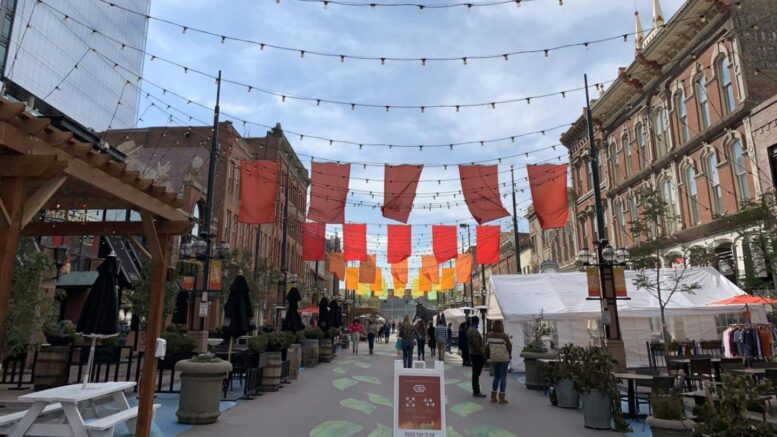The River North Art District in Denver implemented "open streets" and offered in-street outdoor dining during summer 2020. Courtesy of David Rojas/Colorado State University
Most people by now have memorized the public health guidelines meant to help minimize transmission of COVID-19: wash your hands, wear a mask, keep six feet apart from others. That part is easy. What some may not realize is that upholding these guidelines in certain urban areas can present new challenges. For example, how are you supposed to stay six feet apart from other people when the standard width of a sidewalk is only four feet? What do you do when you want to cross an intersection that requires pressing a button to activate the pedestrian signal, but you are avoiding touching any surfaces?
The COVID-19 pandemic has drastically altered the way individuals interact with other people and their environment, but some public health guidelines meant to protect people conflict with the way public spaces and transport in urban areas are built.
Drive, bike, or walk? The illusion of choice
Dr. David Rojas, an epidemiologist in the Department of Environmental and Radiological Health Sciences at Colorado State University, works with policy makers to improve urban design to make cities more inclusive and sustainable, resulting in better health outcomes for people.
In the case of COVID-19, he noticed that when urban areas were not optimized to accommodate mitigation strategies, it put some people in the awkward position of compromising certain public health guidelines to make a necessary trip to their place of work, school, or worship. Or fear of coming in contact with COVID-19 and the inability to safely travel outside the home kept other people inside.
"The decisions we make are dictated by the options we have. How we decide to move, for example, like whether we take a car or walk to work," Rojas said.
Choosing to travel by car may result in a shorter commute, but it can also mean less daily physical activity compared to bicycling or walking. Likewise, taking a bicycle on the road may get the muscles moving, but riding alongside vehicles every day increases exposure to air pollution from car exhaust.
"Some people don't have the time or opportunity to consider other options," Rojas said. "They have to take their kids to school and get to work within a short period of time, but public transportation is too slow or there aren't any bus stations nearby."
Try taking a bicycle to work when there aren't clearly marked bike lanes and traffic moves too quickly to ride safely. Or walking where the intersections and sidewalks are too narrow and the pedestrian crossings are dangerous.
The options available differ for everyone depending on a range of contributing factors, and any number of sustained detriments impact health, causing long-term issues like obesity, cardiovascular disease, or diabetes, among others. Even an increase of vehicles on the road raises the risk of traffic accidents, in turn putting pressure on the health care system that is responsible for treating resulting injuries.
Designing urban areas with everyone in mind leads to better health outcomes all the time, not only during a pandemic. But, when COVID-19 hit in 2020, people all over the world slowed down and cities adapted their mobility patterns and use of space. This shift created the perfect environment for Rojas to highlight opportunities for improvement in urban design geared toward improving health.
"We need to think about how people experience public spaces differently," Rojas said. "If we have better sidewalks, better connectivity, larger parks that are better designed for everyone, it will be good for chronic diseases, cancer, and many other relevant health outcomes."
In an effort to help communities around the world adapt urban areas in light of COVID-19, Rojas worked with an urban planner to create an infographic that details 10 low-cost, temporary interventions to promote urban improvements and public health. The infographic not only identifies interventions that support COVID-19 mitigation strategies, but also explains that many of the changes can be made permanent to contribute to a long-term health vision.
Some of the interventions include adjusting traffic light timing to favor pedestrians and cyclists, expanding public open spaces, and concentrating freight traffic on main roads and at nighttime to improve traffic safety.
The tactical urbanism interventions as an expansion of short-term COVID-19 mitigation strategies are detailed in an article published in Current Environmental Health Reports.
With a projected two-thirds of the human population living in cities by 2050, Rojas asserts that urban designers should plan ahead in the interest of public health. Reponses to the COVID-19 pandemic could provide a push in the right direction.
"We can do two things: make the same mistake of 'copy and paste' regulations or make a change," Rojas said. "We can work with policy makers to not only impact how our cities are designed now, but also to implement better designs for cities created in the future."
Source: Colorado State University

Be the first to comment on "How to Build a City That Prioritizes Public Health"